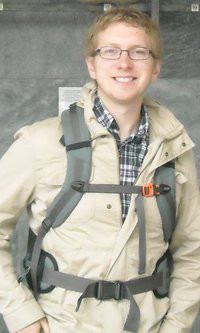
Joel A. Klein Department of History and Philosophy of Science Indiana University 2013-2014 Research Fellow
Nearly thirty years after the Wittenberg Professor of Medicine Daniel Sennert succumbed to the plague, several physicians conspired to rescue and publish a collection of over two hundred of his manuscript letters from the city of Breslau, where they sat, vulnerable to war and rot. It is thus that the 1666 Lyon edition of Sennert’s Opera contains one of the most complete collections of early-modern chymico-medical correspondence. Because these letters were not edited by the authors for publication, and because a large majority were exchanged with Sennert’s closest collaborator, his brother-in-law, Breslau physician Michael Döring, they were written in a relatively candid fashion, and thus provide a unique window into one of the major centers of experimental chymistry and chymical medicine in the early seventeenth century. Likewise, these epistles show the birth of a new chymical medicine in the “chymical college” of the Lutheran university during the Thirty Years’ War, but they also provide a personal context in which we learn that Sennert and Döring were both beset by economic hardship and afflicted by debilitating gout. Sennert’s works were some of the most widely read texts on medicine, natural philosophy, and chymistry in the early seventeenth century, and William R. Newman has recently described the importance of Sennert’s experimental philosophy of corpuscularism to later luminaries such as Robert Boyle. Thus, insofar as these neglected letters historicize Sennert’s natural philosophy and his obsession with the concept of experience, they are significant to our understanding of early-modern science. However, their importantance goes beyond this, for we learn the striking fact that Sennert and Döring spent the majority of their careers collaborating via letters to find a universal medicine that would help against nearly all diseases. More particularly, the two physicians pursued the elusive and mysterious potable gold, as well as similar compounds made from precious metals, and were at times even invested in transmutation. To these ends they exchanged recipes, books, and material substances. They pored over chymical texts (including other collections of letters), tested new compounds on patients with dire prognoses, and even experimented upon themselves. Lacking the recipes for the secretive panaceas of profiteering empirics, such as Georg Am Wald, they attempted to imitate such medicaments by using the principles of rational medicine, doing all explicitly in the name of Christian charity and the public good. My dissertation was written in two parts, and the second part was concerned primarily with Sennert’s letters. I wrote this section while in Philadelphia, supported in part by a two-month research grant from the Philadelphia Area Center for the History of Science (PACHS). I spent the majority of my time working at the Chemical Heritage Foundation, but I also worked in the collections of the College of Physicians Library and the library at the University of Pennsylvania. In addition to providing world-class collections of rare books for me to study, these institutions provided an excellent environment for writing. Beyond simply having a space in which to work, however, the communities at these institutions – and in particular, I refer to the reading group composed of the fellows at the Chemical Heritage Foundation and the PACHS Early Sciences Group – also provided very useful feedback on my work as well as much-appreciated encouragement. In short, the collaboration between these institutions has made Philadelphia into one of the best locations for work on the history of science and medicine, and I am very grateful to have been able to benefit from the resources shared among these institutions. Considered broadly, my whole dissertation focused on the social, intellectual, and cultural interactions among chymistry, medicine, and atomism in the early-modern period. For instance, I argued that Sennert’s interest in potable gold grew directly from his corpuscular philosophy, and that he drew from a medieval medical tradition of Avicennean minima naturalia in which it was believed that medicines that could be reduced to their smallest parts would be able to penetrate and influence the body more deeply. Likewise, Sennert and many of his forebears argued that gold had a special consonance with the body’s quintessence and radical moisture, and thus it was preferable to other compounds. One particular experiment illustrative of this confluence, which held special importance for Sennert in his published works and private letters, was the so-called Philosophical Hen, wherein Sennert attempted to fill a hen’s belly with precious metallic eggs by feeding it silver. When this experiment failed, Sennert rethought his understanding of noble metallic medicines, opting to focus his own efforts on finding a universal purgative rather than a medicine which would strengthen the body’s radical moisture. This, however, did not stop Johann Freitag from formally accusing Sennert of blasphemy and heresy for his atomism and support of such experiments, which he alleged had connotations about the generation of the soul. Taking all of this into account, a major aim of this project was to historicize the generation and transmission of chymico-medical knowledge and experience in the early Republic of Letters and the university. Moving forward, I hope to be able to transition my dissertation into a book, expanding sections on epistolary chymical discourses that I researched while supported by the PACHS fellowship. I will continue to work at the Chemical Heritage Foundation, and I also intend to continue attending functions supported by PACHS, such as the Early Sciences Reading Group.